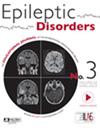Seizure with prominent tonic initial signs followed by psychomotor features: a case report clinically manifesting an unusual ictal evolution
IF 1.9
4区 医学
Q3 CLINICAL NEUROLOGY
引用次数: 0
Abstract
A clinically tonic seizure phase, immediately followed by psychomotor features (right hand dystonic posture, left hand and oral automatisms), was recorded by video and EEG, in a patient who had gliosis of the left temporal lobe and left hippocampal atrophy. Interictal epileptiform discharges were frequently seen in the left temporal area, and at the time of the tonic seizure phase, ictal spike discharges were continuously observed at the left posterior temporal area, which was recognized only by applying a high frequency filter (HFF) of 15 Hz to the digitally recorded EEG because EMG artifacts totally obscured the EEG with a HFF of 60 Hz. It is most likely that tonic seizure can occur in an adult patient with temporal lobe epilepsy, and it is speculated that an epileptogenic focus might activate a certain brain area which is regarded as a symptomatogenic zone for tonic seizures. If the tonic seizure phase is immediately followed by psychomotor features as seen in the present patient, the former could be due to focal epilepsy.具有突出强直性初始症状和精神运动特征的癫痫发作:临床表现为不寻常发作演变的病例报告
通过视频和脑电图记录了一名患有左颞叶胶质病变和左侧海马萎缩的患者的临床强直性发作阶段,紧接着出现了精神运动特征(右手肌张力障碍姿势、左手和口腔自动症)。发作间期痫样放电经常出现在左颞区,在强直性发作阶段,发作期尖峰放电持续出现在左后颞区,只有在数字记录的脑电图上应用 15 Hz 的高频滤波器(HFF)才能识别,因为 EMG 伪影完全掩盖了 60 Hz 高频滤波器的脑电图。成人颞叶癫痫患者很可能会出现强直性发作,据推测,致痫灶可能会激活某个脑区,而该脑区被认为是强直性发作的症状致病区。如果强直性发作阶段之后立即出现精神运动特征,就像本例患者一样,前者可能是局灶性癫痫所致。
本文章由计算机程序翻译,如有差异,请以英文原文为准。
求助全文
约1分钟内获得全文
求助全文
来源期刊

Epileptic Disorders
医学-临床神经学
CiteScore
4.10
自引率
8.70%
发文量
138
审稿时长
6-12 weeks
期刊介绍:
Epileptic Disorders is the leading forum where all experts and medical studentswho wish to improve their understanding of epilepsy and related disorders can share practical experiences surrounding diagnosis and care, natural history, and management of seizures.
Epileptic Disorders is the official E-journal of the International League Against Epilepsy for educational communication. As the journal celebrates its 20th anniversary, it will now be available only as an online version. Its mission is to create educational links between epileptologists and other health professionals in clinical practice and scientists or physicians in research-based institutions. This change is accompanied by an increase in the number of issues per year, from 4 to 6, to ensure regular diffusion of recently published material (high quality Review and Seminar in Epileptology papers; Original Research articles or Case reports of educational value; MultiMedia Teaching Material), to serve the global medical community that cares for those affected by epilepsy.
 求助内容:
求助内容: 应助结果提醒方式:
应助结果提醒方式:


